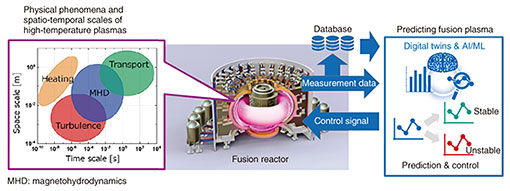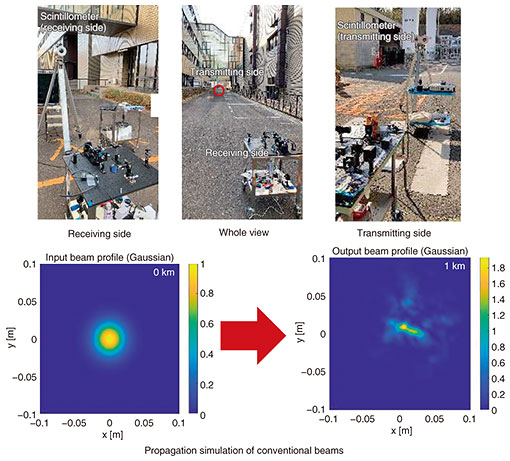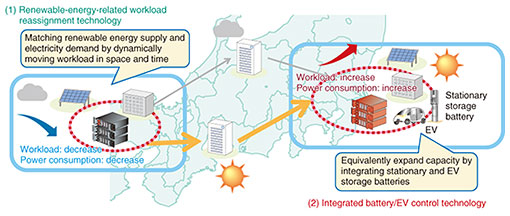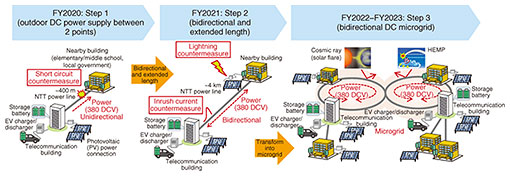 |
|||||||||||
|
|
|||||||||||
|
Feature Articles: Activities toward Zero Environmental Impact and Environmental Adaptation to Build a Resilient Society Vol. 21, No. 2, pp. 22–27, Feb. 2023. https://doi.org/10.53829/ntr202302fa2 Next-generation Energy Technology Contributing to Zero Environmental ImpactAbstractWith the aim of building a sustainable society, NTT Space Environment and Energy Laboratories is engaged in research toward the creation of clean and environmentally sound energy and the smart use of energy. In this article, we introduce technologies related to fusion power and space solar power, which are overwhelmingly clean and inexhaustible energy sources, virtual energy demand/supply control technology that makes the most effective use of renewable energy, and next-generation energy supply technology based on highly reliable and highly efficient direct-current power supply systems. Keywords: innovative clean energy, renewable energy, zero environmental impact 1. Optimal operation technologies for fusion reactorsTo enable fusion reactors for fusion power generation, it is necessary to maintain the stability of the burning plasma for a long time. Therefore, we aim to develop an optimal operation technology for fusion reactors to achieve high-speed control for plasma stabilization by using the Innovative Optical and Wireless Network (IOWN) and artificial intelligence/machine learning (Al/ML). For this approach, we need knowledge on fusion physics, so collaboration with partners promoting fusion research is essential. Therefore, we have concluded a comprehensive cooperation agreement with the ITER International Fusion Energy Organization (ITER Organization) [1] and a cooperation agreement with National Institutes for Quantum Science and Technology (QST) [2] to promote research and development. In past fusion research experiments conducted worldwide, the plasma maintenance time was several tens of seconds, and the out-versus-in power amplification ratio of the fusion reaction (fusion power/total input heating power) was Q = 1.25. The ITER project, the largest fusion research project in history, was launched to further improve these characteristics. The target value of the plasma maintenance time is about 3600 s, and the out-versus-in power amplification ratio of the fusion reaction is Q = 10. Plasma control is executed by confinement magnetic field control, plasma heating control, and fuel-supply control. However, real-time control is difficult. Plasma behavior is very complicated because there are many particle species. Each has a different kinetic velocity, and different physical phenomena on a spatio-temporal scale coexist. They also all interact with each other. It takes time from measurement to analysis since the plasma fluctuates over an ultrashort period on the order of 10-8 s when we measure and analyze a specific event change and control to correct the plasma behavior. The response time of the control equipment is also much slower than the analysis, so the control cannot be conducted in time. Hence, we aim to stabilize fusion plasma and increase the fusion power in two steps. First step is predicting fusion-plasma behavior in the near future with a high-speed calculation based on the time evolution data and current measurement data of fusion plasma. The second step is proactively controlling the fusion plasma. In past operation, fusion plasma was controlled by determining the position and shape of the plasma. However, we can also control plasma instability more quickly by obtaining information on the inside of the plasma in real time. Therefore, we are developing an algorithm based on AI/ML for modeling plasma behavior. We will achieve the optimum operation of fusion reactors by combining this algorithm with a high-speed, high-capacity, and low-latency control network compared with the current control network (Fig. 1).
2. Space solar power systemSpace solar power system technology is a technology in which energy obtained from sunlight by using a geostationary satellite 36,000 km above Earth is delivered to Earth by means of laser beam and microwaves day and night and converted into electric power and other energy for use on Earth. We focus on the laser beam, which has a smaller beam spread angle than microwaves and is easier to transmit over long distances, and are advancing research on this technology in three areas. The first is a technology to convert sunlight gathered in space into a laser beam. Because of limits on the weight and volume of satellites, it is necessary to convert sunlight into a laser beam in the smallest possible configuration. Therefore, we are engaged in research on solar-pumped laser technology that can convert sunlight directly into a laser beam without using electric power. Thus far, we have grown Nd/Cr: YAG*1 crystals for the laser medium, which can absorb light in the wavelength band of sunlight and produce an infrared laser beam of 1064 nm, and confirmed laser oscillation in the laboratory. We plan to optimize the composition of the crystal to achieve high efficiency and high power output, improve its durability and longevity, and develop a device that can concentrate sunlight and capture it efficiently in the laser. The second is a technology for laser beams to be able to reach far distances accurately. The characteristics of laser beams is that they are highly linear and easily transmitted over long distances, but when transmitted over distances as far as 36,000 km, the normal laser beams spread over a range of several 10 m due to diffraction. It is also assumed that when passing through the atmosphere, the aim of the laser beam is disturbed by several meters because it is affected by atmospheric fluctuations called atmospheric disturbances. Therefore, we are studying transmission methods suitable for long-distance transmission of laser beams. Special beams, such as the Bessel beam*2 and Laguerre-Gaussian beam*3, which are said to be resistant to diffraction and disturbance, can be formed by phase modulation. We have verified their effects on diffraction and disturbance through simulations and ground-based transmission experiments and are studying beams that are more resistant to disturbance and reach long distances (Fig. 2).
The third is photoelectric conversion technology that can withstand high-intensity laser light arriving from space and convert this light into power with high efficiency. We aim to convert laser light into electric power with a conversion efficiency that far exceeds that of conventional solar cells by developing a photoelectric conversion device tuned specifically for the wavelength of laser light. However, the theoretical limit of the conversion efficiency of compound semiconductors, which is expected to be the most feasible, is about 50%, so about half the conversion is heat. Thus, we are also studying other ways to use laser energy such as generating hydrogen and ammonia through thermochemical reactions.
3. Virtual energy demand/supply control technologyVirtual energy demand/supply control is a technology for using renewable energy more efficiently without waste by adjusting the power consumption of information and communication technology (ICT) equipment, such as servers and routers, installed in NTT’s datacenters located across the country (Fig. 3). While expectations are rising for the large-scale implementation of renewable energy to stand against climate change, since the amount of power generated by most renewable energy sources fluctuates depending on weather conditions, it becomes more difficult to maintain a balance between supply and demand in individual regions as more renewable energy sources are introduced. Therefore, we are conducting research and development on a technology to balance power supply and demand by reassigning the information processing of ICT equipment in NTT’s datacenters across regions in accordance with the gap between demand and the amount of renewable energy generation in each region (renewable-energy-related workload reassignment technology). We are also developing a technology to enhance the supply-demand adjustment capability in NTT’s datacenters by providing integrated control of stationary and on-vehicle storage batteries (integrated battery/electric vehicle (EV) control technology).
Within NTT’s datacenters, ICT equipment executes information and communications processing to provide a variety of services. The work processed with such equipment is generally referred to as “workload.” Datacenter workloads consume power so great that datacenters are likely to benefit the most from workload reassignment. Therefore, we are focusing on developing elemental technologies for servers in datacenters. This technology consists of three phases: forecasting, optimization, and control. In the forecasting phase, we are trying to break down the power consumption of servers by workload and forecast each workload separately. In the optimization phase, we set the target power-consumption value for each timeframe and each region to reduce energy-supply-demand gaps then create a workload reassignment pattern as a control plan for achieving the target values while preventing service quality from deteriorating. This has made it possible to simultaneously handle both spatiotemporally movable workloads, such as scientific and technical computing, and spatially movable (temporally unmovable) workloads, such as virtual desktops. In the control phase, workload reassignment and communication-traffic routing are executed using virtualization technology on the basis of an optimized control plan. We believe that the expected decentralization of datacenters will further enhance the benefits of this technology. 4. Next-generation energy supply technologyNext-generation energy supply technology makes local production for local consumption of renewable energy and resilient energy supply possible by using safe and highly reliable direct-current (DC) power supply systems. The power supply systems of NTT’s telecommunication buildings supply ICT equipment with an electric power of 48 or 380 DCV and can directly supply power from storage batteries during power outages. By developing this technology established by NTT, we aim to distribute power combining DC power and renewable energy in the area around NTT’s telecommunication buildings and to provide safe power supply without power outages even during disasters. Since the storage battery is directly connected to the power supply line, stable power supply is possible even if electromagnetic pulses of HEMP (high-altitude electromagnetic pulse) or cosmic rays come down to the ground. Therefore, this power supply technology is expected to be less affected by cosmic rays from solar flares caused by solar activity, which is expected to increase in 2025. Forming a DC microgrid enables power interchange among a number of consumer buildings with distributed energy resources as well as power-outage risk reduction. To implement this system, we are proceeding using 380 DCV with a three-step study, as shown in Fig. 4. In FY2020, as step 1, we implemented technology that enables a one-to-one connection between an NTT telecommunication building and elementary and junior high schools that serve as evacuation shelters. The power supply distance is 400 m or less. For short-circuit accidents that occur when the plus and minus of a power supply line are connected, we implemented electrical safety technology by assembling a conventional fuse and overcurrent protection function (gate block) inside the DC-power-supply device.
In FY2021, as step 2, we promoted the development of technology to extend the power supply distance (4 km) from an NTT telecommunication building to a consumer building and technology to bi-directionally supply power. As the power supply distance increases, the impedance component (inductance component against the resistance component) of the power supply line increases. Therefore, when the power is turned on, the voltage drop, which is caused by an inrush current, increases. This shows the high possibility that the DC-power-supply device will stop. Therefore, we clarified the relationship between the power supply distance and value of the voltage drop due to the capacitance of the capacitor and derived the conditions necessary to avoid equipment outages. Regarding the bidirectional power supply technology, when a number of photovoltaic power (PV) systems and bidirectional EV chargers are installed in consumer buildings, the risk of lightning surges entering the NTT telecommunication building via power supply lines increases because the ground potential increases when a lightning strikes these systems. Therefore, by focusing on potential equalization, which is the basis of lightning countermeasures, and clarifying the conditions for connecting various ground electrodes safely and effectively, the rise in ground potential can be prevented without adding new countermeasure systems. Then, the risk of lightning surges entering telecommunication buildings decreases. Using these technologies, in collaboration with NTT Anode Energy, we are conducting demonstrations of power backup for evacuation shelters during disasters, with the aim of developing a smart energy system for Chiba City. As step 3, we will proceed with research on DC microgrids and work on DC-power-supply resistance to solar flares that are expected to increase in 2025. 5. Future developmentsToward the creation of innovative energy, for optimal operation of fusion reactors, we will collaborate with the ITER Organization and QST to advance technology demonstrations that will lead to the success of experimental fusion reactors and actualization of fusion power generation, and in the field of space solar power system technology, we will advance the early deployment of technologies such as energy transmission on the ground while developing technologies in space. For the effective use of renewable energy, which will be introduced in large quantities in the future, we aim to achieve local production for local consumption of energy by promoting demand/supply control in multiple buildings using virtual energy demand/supply control technology and enable new power accommodation and resilient power supply with DC microgrids using next-generation energy supply technology. We will aim for zero environmental impact by establishing these technologies. References
|
|||||||||||

















